|
|
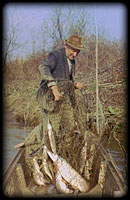 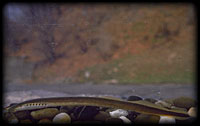 Most important vertebrates of the Tisza are indisputably fishes. Survey of fish fauna of the river, just becauce of its value, has been started already at the end of the last century and on the basis of results of more or less regular research, now we have a relatively exact picture about fish fauna of the river. Number of species described from the river is altogether 68, which is prominent considering the number of species of European freshwater fishes. As an effect of gradient like changes in environmental conditions the river can be divided into more sections according to its fish fauna. This is typical to all water courses, but due to dammings natural sections almost disappeared for today in the most European rivers. On the Tisza this division, which can be perceived still today proves the natural value of the river. Certain sections are given by the name of species dominant there. So in order we can find the level of trout, grayling, nose, barbel, common bream, ruffle, and dab (flat-fish). With the exception of the latter all levels can be found in the Tisza. Trout level of the river is typical of Black and White Tisza, and on the united Tisza as far as Rahó. Its common species are broun trout (Salmo trutta fario), minnow (Phoxinus phoxinus), stone loach (Barbatula barbatula), bullhead and Siberian bullhead (Cottus gobio and C. poecilopus, respectively). We have to emphasize the presence of the Carpathian endemic Carpathian lamprey (Eudontomyzon danfordi), which lives exclusively here and in some tributaries of the Tisza. Characteristic species of the grayling level - which can be found between Most important vertebrates of the Tisza are indisputably fishes. Survey of fish fauna of the river, just becauce of its value, has been started already at the end of the last century and on the basis of results of more or less regular research, now we have a relatively exact picture about fish fauna of the river. Number of species described from the river is altogether 68, which is prominent considering the number of species of European freshwater fishes. As an effect of gradient like changes in environmental conditions the river can be divided into more sections according to its fish fauna. This is typical to all water courses, but due to dammings natural sections almost disappeared for today in the most European rivers. On the Tisza this division, which can be perceived still today proves the natural value of the river. Certain sections are given by the name of species dominant there. So in order we can find the level of trout, grayling, nose, barbel, common bream, ruffle, and dab (flat-fish). With the exception of the latter all levels can be found in the Tisza. Trout level of the river is typical of Black and White Tisza, and on the united Tisza as far as Rahó. Its common species are broun trout (Salmo trutta fario), minnow (Phoxinus phoxinus), stone loach (Barbatula barbatula), bullhead and Siberian bullhead (Cottus gobio and C. poecilopus, respectively). We have to emphasize the presence of the Carpathian endemic Carpathian lamprey (Eudontomyzon danfordi), which lives exclusively here and in some tributaries of the Tisza. Characteristic species of the grayling level - which can be found between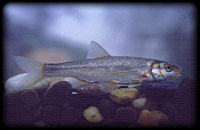 Rahó abd Huszt on the river- is grayling (Thymallus thymallus), but two Euro-Mediterranean subspecies can be also mentioned, among which souffie (Leuciscus souffia agassizi) can be found only here, but Balkan barbel (Barbus meridionalis petényi) is also a very interesting element of the Upper Tisza fish fauna. Nose zone is a transitional course, typical of rivers, Which is characterized by the transition of mountain and lowland conditions. The section between Huszt and Tiszacsécse, already in Hungary, Rahó abd Huszt on the river- is grayling (Thymallus thymallus), but two Euro-Mediterranean subspecies can be also mentioned, among which souffie (Leuciscus souffia agassizi) can be found only here, but Balkan barbel (Barbus meridionalis petényi) is also a very interesting element of the Upper Tisza fish fauna. Nose zone is a transitional course, typical of rivers, Which is characterized by the transition of mountain and lowland conditions. The section between Huszt and Tiszacsécse, already in Hungary, 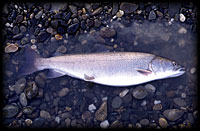 belongs to this level. Nose (Chondrostoma nasus), which gave the name of the level, can be found in a great number, and there is a large population of the endangered schneider (Alburnoides bipunctatus)very sparse in Europe. Carpathian endemic Huchen (Hucho hucho) also belongs the fish fauna of the level, this is one of the largest trouts, and the endemic Danubian gudgeon (Gobio uranoscopus) occurring also only in the water regime of the Danube. The lower border of the barbel level is ambiguous, in fact till Tokaj relatively significant stocks can be found of species typical to the level, but partly as an effect of the polluted water of the Szamos, partly thanks to operation of the Tisualök barrage below Záhony the number of the level of common bream increases strongly. A frequent species of the barbel level belongs to this level. Nose (Chondrostoma nasus), which gave the name of the level, can be found in a great number, and there is a large population of the endangered schneider (Alburnoides bipunctatus)very sparse in Europe. Carpathian endemic Huchen (Hucho hucho) also belongs the fish fauna of the level, this is one of the largest trouts, and the endemic Danubian gudgeon (Gobio uranoscopus) occurring also only in the water regime of the Danube. The lower border of the barbel level is ambiguous, in fact till Tokaj relatively significant stocks can be found of species typical to the level, but partly as an effect of the polluted water of the Szamos, partly thanks to operation of the Tisualök barrage below Záhony the number of the level of common bream increases strongly. A frequent species of the barbel level 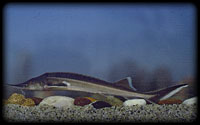 is barbel (Barbus barbus), chub (Leuciscus cephalus), species typically living here aer sterlet (Acipenser ruthenus), dace (Leuciscus leuciscus), zahrte (Vimba vimba), burbot (Lota lota), Danubian roach (Rutilus pigus virgo), Kessler's gudgeon (Gobio kessleri), zingel and streber (Zingel zingel and Z. streber, respectively). Among these Danubian roach is very sparse, the endemic species of the Carpathians, while the three latter have a very small distribution, they can be found in greater quantities only in the water regime of the Danube, hence their presence in the Tisza has a prominent importance. Presence of ship sturgeon (Acipenser nudiventris), occurring very sparsely has also a great importance. The course of the Tisza below Záhony till the mouth belongs the level of the bream, providing variable habitats is barbel (Barbus barbus), chub (Leuciscus cephalus), species typically living here aer sterlet (Acipenser ruthenus), dace (Leuciscus leuciscus), zahrte (Vimba vimba), burbot (Lota lota), Danubian roach (Rutilus pigus virgo), Kessler's gudgeon (Gobio kessleri), zingel and streber (Zingel zingel and Z. streber, respectively). Among these Danubian roach is very sparse, the endemic species of the Carpathians, while the three latter have a very small distribution, they can be found in greater quantities only in the water regime of the Danube, hence their presence in the Tisza has a prominent importance. Presence of ship sturgeon (Acipenser nudiventris), occurring very sparsely has also a great importance. The course of the Tisza below Záhony till the mouth belongs the level of the bream, providing variable habitats 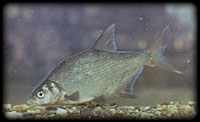 for fishes. Number of species occurring here exceeds 50. Its nature conservation value is increased by stocks of fish species rare or just endangered in Europe, such as betterling (Rhodeus sericeus amarus), asp (Aspius aspius), whitefin gudgeon (Gobio albipinnatus), wels (Silurus glanis), or only the occurrence of some, such as Balkan spined loach (Sabanejewia aurata), mud loach (Misgurnus fossilis), moderlieschen (Leucaspius delineatus), and the presence of endemic species, such as (Balon's ruffe (Gymnocephalus baloni), striped ruffe (G. schraetzer), European mudminnow (Umbra krameri). Most common are those limnophilous species, which during their life are tightly linking to streaming water, but the reproduction of which takes place mainly in the overflows of the river. There are silver bream (Blicca bjoerkna), blue bream (Abramis ballerus), common bream (Abramis brama), carp (Cyprinus carpio), for fishes. Number of species occurring here exceeds 50. Its nature conservation value is increased by stocks of fish species rare or just endangered in Europe, such as betterling (Rhodeus sericeus amarus), asp (Aspius aspius), whitefin gudgeon (Gobio albipinnatus), wels (Silurus glanis), or only the occurrence of some, such as Balkan spined loach (Sabanejewia aurata), mud loach (Misgurnus fossilis), moderlieschen (Leucaspius delineatus), and the presence of endemic species, such as (Balon's ruffe (Gymnocephalus baloni), striped ruffe (G. schraetzer), European mudminnow (Umbra krameri). Most common are those limnophilous species, which during their life are tightly linking to streaming water, but the reproduction of which takes place mainly in the overflows of the river. There are silver bream (Blicca bjoerkna), blue bream (Abramis ballerus), common bream (Abramis brama), carp (Cyprinus carpio), 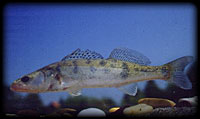 and pikeperch (Stizostedion lucioperca). Rheophilous, i. e. stream-loving species of the level live here also in large number, such as Danubian bream (Abramis sapa), orf (Leuciscus idus), whitefin gudgeon (Gobio albipinnatus), Balkan spined loach (Sabanejewia aurata) and striped ruffe (Gymnocephalus schraetzer). Occurrence of rheophilous species of the barbel level makes the picture of the fish fauna more colourful, but sometimes - mainly due to inundations - certain species of higher levels appear as well such as brown and rainbow trout (Salmo trutta fario and Salmo irideus, respectively), and the definitely marshy species of dead beds and navvy holes, such as European mudminnow (Umbra krameri), mud loach (Misgurnus fossilis) and moderlieschen (Leucaspius delineatus). Due to settlements artificially or accidently introduced or spontaneously spreading species occur in significant quantity here. and pikeperch (Stizostedion lucioperca). Rheophilous, i. e. stream-loving species of the level live here also in large number, such as Danubian bream (Abramis sapa), orf (Leuciscus idus), whitefin gudgeon (Gobio albipinnatus), Balkan spined loach (Sabanejewia aurata) and striped ruffe (Gymnocephalus schraetzer). Occurrence of rheophilous species of the barbel level makes the picture of the fish fauna more colourful, but sometimes - mainly due to inundations - certain species of higher levels appear as well such as brown and rainbow trout (Salmo trutta fario and Salmo irideus, respectively), and the definitely marshy species of dead beds and navvy holes, such as European mudminnow (Umbra krameri), mud loach (Misgurnus fossilis) and moderlieschen (Leucaspius delineatus). Due to settlements artificially or accidently introduced or spontaneously spreading species occur in significant quantity here.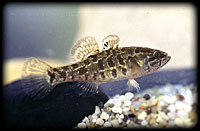 Among these introduced silver and bighead carp - or rather the hybrids of them - (Hypophthalmychtis molitrix × Aristichthys nobilis) "amur" (Ctenopharyngodon idella), black bullhead (Ictalurus melas), brown bullhead (I. nebulosus) are worthy of mention, a Pontic-Caspian goby species (Proterorhinus marmoratus) appearing in the 1990's, spreading spontaneously from the Lower Danube. We have tos speak about a new species, which is a good example of consequences of irresponsible introduction of fishes. This is an other goby species (Perccottus glehni), first described in 1998, now widespread on the area. This very tough carnivorous fish, growing to a length of 20-25 cm is native from the region of the Amur to Central China. Among these introduced silver and bighead carp - or rather the hybrids of them - (Hypophthalmychtis molitrix × Aristichthys nobilis) "amur" (Ctenopharyngodon idella), black bullhead (Ictalurus melas), brown bullhead (I. nebulosus) are worthy of mention, a Pontic-Caspian goby species (Proterorhinus marmoratus) appearing in the 1990's, spreading spontaneously from the Lower Danube. We have tos speak about a new species, which is a good example of consequences of irresponsible introduction of fishes. This is an other goby species (Perccottus glehni), first described in 1998, now widespread on the area. This very tough carnivorous fish, growing to a length of 20-25 cm is native from the region of the Amur to Central China.
|
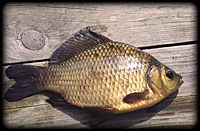 Dead beds within the forebank and on the protected side have a typical, stagnant water or marsh fish fauna. The composition of the fish-stock is determined by the state of filling up, the possibility of water supply and the mode of their utilization too. We have to emphasize their role in replacement of fish-stock of the Tisza. It is not accidental, that in flood years the quantity of fish-stock of the Tisza multiplies. Fish fauna of mortlakes having a permanent water supply is more rich, beside dominant, limnophilous and stagnophilous elements together with the feeding water species preferring flowing water get in from time to time, such species are blue bream (Abramis ballerus), Danubian bream (Abramis sapa), or even the barbel level chub (Leuciscus cephalus) and zahrte (Vimba vimba). Characteristic species arecommon bream (Abramis brama), roach (Rutilus rutilus), gibel carp (Carassius auratus), brown bullhead (Ictalurus nebulosus), black bullhead (I. melas), among carnivores pike and Dead beds within the forebank and on the protected side have a typical, stagnant water or marsh fish fauna. The composition of the fish-stock is determined by the state of filling up, the possibility of water supply and the mode of their utilization too. We have to emphasize their role in replacement of fish-stock of the Tisza. It is not accidental, that in flood years the quantity of fish-stock of the Tisza multiplies. Fish fauna of mortlakes having a permanent water supply is more rich, beside dominant, limnophilous and stagnophilous elements together with the feeding water species preferring flowing water get in from time to time, such species are blue bream (Abramis ballerus), Danubian bream (Abramis sapa), or even the barbel level chub (Leuciscus cephalus) and zahrte (Vimba vimba). Characteristic species arecommon bream (Abramis brama), roach (Rutilus rutilus), gibel carp (Carassius auratus), brown bullhead (Ictalurus nebulosus), black bullhead (I. melas), among carnivores pike and 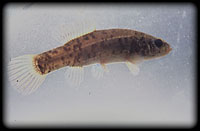 pikeperch (Stizostedion lucioperca). In places with waterweeds there are large numbers of bitterling (Rhodeus sericeus amarus), rudd (Scardinius erythrophthalmus), perch (Perca fluviatilis), pumpkinseed (Lepomis gibbosus) and in addition, many valuable stagnophilous species can be found here in relatively considerable stocks, e. g. tench (Tinca tinca), crucian carp (Carassius carassius), mud éoach (Misgurnus fossilis), spined loach (Cobitis taenia), moderlieschen (Leucaspius delineatus) and European mudminnow (Umbra krameri). In mortlakes with temporary water supply only species adapted to lower oxygen level can survive on a longer period. In such waters only one or two dominant species are present sometimes in large numbers. Characteristic species aregibel carp, roach, moderlieschen, betterling and mud loach. In dead beds of angling utilization the composition of fish-stock - and mostly aquatic circuits as well - are determined by settlings. pikeperch (Stizostedion lucioperca). In places with waterweeds there are large numbers of bitterling (Rhodeus sericeus amarus), rudd (Scardinius erythrophthalmus), perch (Perca fluviatilis), pumpkinseed (Lepomis gibbosus) and in addition, many valuable stagnophilous species can be found here in relatively considerable stocks, e. g. tench (Tinca tinca), crucian carp (Carassius carassius), mud éoach (Misgurnus fossilis), spined loach (Cobitis taenia), moderlieschen (Leucaspius delineatus) and European mudminnow (Umbra krameri). In mortlakes with temporary water supply only species adapted to lower oxygen level can survive on a longer period. In such waters only one or two dominant species are present sometimes in large numbers. Characteristic species aregibel carp, roach, moderlieschen, betterling and mud loach. In dead beds of angling utilization the composition of fish-stock - and mostly aquatic circuits as well - are determined by settlings.
|
Other vertebrate species linking to the Tisza
|
|
###### gyurgyalag by kari#### Bird life of the river and adjacent areas also has a great diversity. The river valley makes one of the most important route of north-south bird migration. Number of species nesting and rambling here in a year multiplies during the migration season, observed number of species exceeds 200. In steep walls of falling banks of the Tisza sand martin (Riparia riparia) nests in colonies of more thousands, and in a lower number bee-eater (Merops apiaster), and we can met kingfisher (Alcedo atthis) on the same place. In riverine galleries grey herons (Ardea cinerea), night herons (Nycticorax nycticorax), great white and little egrets (Egretta alba and E. garzetta, respectively), spoonbills (Platalea leucorodia), and squacco herons (Ardeola ralloides) 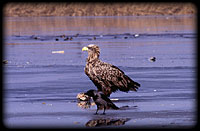 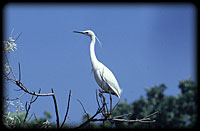 together form vast mixed colonies. On mountain areas nests golden eagle (Aquila chrysaëtos), rare nesting bird of old flood plain forests is white-tailed eagle (Haliaëtus albicilla), but itt lesser spotted eagle (Aquila pomarina), honey buzzard (Pernis apivorus), black stork (Ciconia nigra), black woodpecker (Dryocopus martius) and the more and more frequent raven (Corvus corax) also nests here. Forebank forests are typical habitats of olivaceous warbler (Hippolais pallida) and thrush nightingale (Luscinia luscinia), and black kite (Milvus migrans) also breed here. Number of species breeding in the forebank of the river in Hungary is about 130. Characteristic nesting birds of more open, grove like areas are roller (Coracias garrulus), hobby (Falco subbuteo), grey-headed woodpecker (Picus canus) and in certain years short-eared owl (Asio flammeus). together form vast mixed colonies. On mountain areas nests golden eagle (Aquila chrysaëtos), rare nesting bird of old flood plain forests is white-tailed eagle (Haliaëtus albicilla), but itt lesser spotted eagle (Aquila pomarina), honey buzzard (Pernis apivorus), black stork (Ciconia nigra), black woodpecker (Dryocopus martius) and the more and more frequent raven (Corvus corax) also nests here. Forebank forests are typical habitats of olivaceous warbler (Hippolais pallida) and thrush nightingale (Luscinia luscinia), and black kite (Milvus migrans) also breed here. Number of species breeding in the forebank of the river in Hungary is about 130. Characteristic nesting birds of more open, grove like areas are roller (Coracias garrulus), hobby (Falco subbuteo), grey-headed woodpecker (Picus canus) and in certain years short-eared owl (Asio flammeus).
|
|
Among mammals the more considerable stocks of the carnivore (Carnivora) brown bear (Ursus arctos) and wolf (Canis lupus) are worthy of mention, which occur only on the mountain course of the Tisza flood area. Also in mountain and sub-mountain forests lynx (Lynx lynx) is typical. Carnivores of forebank forests are pine-marten (Martes martes), in larger forests wild cat (Felis silvestris) and badger (Meles meles) is not rare. In the forebank on the total length of the river otter (Lutra lutra) is present in a considerably stable stock. The largest mammal occurring here is red deer (Cervus elaphus). Roe-deer (Capreolus capreolus), wild boar (Sus scrofa) and fox (Vulpes vulpes) are common. Many species of rodents (Rodentia) and bats (Chiroptera) inhabit the forebank areas too.
|